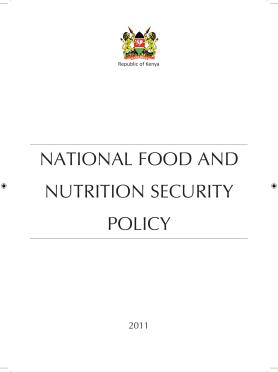KEN 2011 National Food and Nutrition Security Policy
KEN 2011 National Food and Nutrition Security Policy
About half of Kenya’s estimated 38.5 million people are poor, and some 7.5 million people live in extreme poverty, while over 10 million people suffer from chronic food insecurity and poor nutrition. In recent years, it is estimated that at any one time about two million people require assistance to access food. During periods of drought, heavy rains and/or floods, the number of people in need could double.
Economic performance has a direct bearing on people’s food security and nutrition status in Kenya although it is acknowledged that improved economic status alone is not sufficient to ensure nutrition security. In the first two decades after independence, the country witnessed a significant growth and improvement in living standards. However, economic growth was either stagnant or negative (compared to high population growth rates) in the 1980s and 1990s. In the agricultural sector, annual growth rates declined from 6% in the 1960s to 1.3% in the 1990s. In recent years, there have been upturn of Kenya’s economy, providing renewed opportunity to enhance food security and nutrition. In 2005, the economy grew by 5.8 % while in 2006 it grew by 6%. As a result the absolute poor dropped from 56% in 2003/04 to 46% in 2006.

